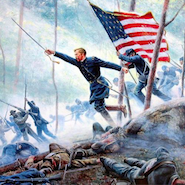- About
- Subscribe Now
- New York,
April 2, 2015

NEW YORK - Experiences are the root of a consumer’s interaction with a brand, therefore this interactive model must also turn inward to train and educate employees in a hands-on and informative manner.
At the Luxury Marketing Council’s “The Power of Leadership Education: The Gettysburg Experience” luncheon, executives from the New Haven Consulting Group spoke about learning from history and using lessons learned 150 years ago in the Civil War with brands. Vision, alignment and execution are the three leadership qualities needed to lead troops into battle and are the same characteristics necessary to take charge within a company.
"Leadership challenges are timeless," said Rick Milczanowski, director of consulting services at New Haven Consulting Group, Inc., Shelton, CT.
"Action learning takes the leader out of their comfort zone and put them in situations where they have to think differently given the scenario and what lessons [they] can learn and bring it back to the workplace," Mr. Milczanowski said.
Fix your bayonets
It is commonly believed that those who do not learn the lessons from history are condemned to repeat them. The New Haven Consulting Group is using this thought and bringing executives and leaders back to their American history lessons to learn about the bloodiest battle on American soil: The Gettysburg battle.
However, this time, the lesson is not taught in a classroom, but rather in the battle location in Gettysburg, PA.
In July 1863, the Union and Confederate armies crossed paths north of Washington in Gettysburg. New Haven Consulting Group creates different scenarios with descriptions of the generals in charge and their actions at the battle.
For instance, when General Buford and his cavalry army first crossed paths with the Confederates, he chose to reach higher ground while waiting for help. When General Reynolds arrives he orders his troops to charge the woods where the Confederates are camped. General Reynolds dies in this attack.
The first union General used strategic leadership to make a quick plan, but General Reynolds used tactical leadership skills and took immediate charge without thinking of consequences.
After the descriptions of each scenario, the executives and leaders are encouraged to discuss each Civil War general’s strengths and weaknesses as leaders and think of themselves and leaders they have encountered.
Further examples include generals who disobey orders and those who question the leadership, but then follow. The occurrences from more than 150 years ago are easily translatable to modern day companies.
Leaders in both situations struggle with the notion of power over versus power with. Those who hold the power but are with their employees executing ideas often see better results than those who are ruling from above and not understanding the daily struggles and issues that arise.
One example given by Mr. Milczanowski was Colonel Joshua Chamberlain who was leading troops who were out of ammunition, surrounded by Confederates and consequently had low motivation. Regardless, Colonel Chamberlain demanded his men to “fix their bayonets” and charge; he led the attack with his sword out. Colonel Chamberlain and his 80 men took 400 prisoners and won the battle.
Brands and their C-level executives are often out of touch with the operations that occur throughout the company, but looking at statistics and understanding the demands of both their employees and their consumers while leading with them can change the operation of a brand from top down.
New Haven Consulting Group has worked with top brands in both the luxury and mass market realms.
Shut up and listen
Listening to consumers is often thought to be key for brands looking to personalize experiences, but only 25 percent of C-suite executives have formal listening program, according to a new survey conducted by Shullman Research Center.
This survey highlights the lack of listening programs as well as the benefits a brand may redeem if it had a formal platform. By having an official method of listening, brands can redeem benefit in revenue, efficiency and marketing and develop a deeper connection with their consumers (see story).
Listening to both consumers and employees can change the way in which a company is ran and leaders lead.
"I would have to say that [ego] is maybe the fourth thing, vision alignment, execution and ego," Mr. Milczanowski said. "When we have leadership, I think you have to have some level of ego if you are going to be asking people to follow you.
“Enlightened management realizes that a lot of the intelligence about the brand or about the battle comes from the people on the line," he said.
Final Take
Nancy Buckley, editorial assistant on Luxury Daily, New York
Share your thoughts. Click here